Joint Optimization of Ticket Pricing and Allocation on High-Speed Railway Based on Dynamic Passenger Demand during Pre-Sale Period: A Case Study of Beijing–Shanghai HSR
Abstract
:1. Introduction
2. Literature Review
2.1. Ticket Allocation Problem
2.2. Dynamic-Pricing Problem
2.3. Joint Optimization of Ticket Allocation and Dynamic Pricing
2.4. Research Ideas
- (1)
- The existing dynamic pricing studies mainly focused on the characteristics of uneven distribution of passenger flow throughout a given year, with differential pricing for high and low seasons or differential pricing for the same Origin–Destination (OD) parallel train service index, ignoring the law of the distribution of passenger demand during the pre-sale period. In addition, because the intensity of passenger demand for tickets varies in different periods of the pre-sale period, the existing studies only considered the overall situation of passenger demand, and seldom considered the characteristics of dynamic passenger demand for tickets in different periods of the pre-sale period.
- (2)
- The existing ticket pricing and allocation joint optimization studies rarely considered the feedback relationship between the two. The dynamic adjustment of the ticket price will directly affect the passenger demand and, consequently, affect the ticket allocation scheme. In addition, the ticket pre-allocation scheme is also the basis for the implementation of dynamic pricing.
3. Mathematical Model
3.1. Problem Description
3.1.1. Problem Analysis
3.1.2. Assumptions
- (1)
- Only the single train problem is studied, and the transfer of passenger demand between the single train and other trains is not considered.
- (2)
- The ticket-purchasing behaviors of passengers in each OD section in each period in pre-sale period are independent of each other.
- (3)
- Since the current railway pre-sale period is only 15 days, passengers do not have much time to analyze the future trend of ticket prices. Therefore, it is assumed that passengers in each period of pre-sale period are short-sighted.
- (4)
- There is no overselling strategy, and the passenger behavior of refund and ticket change is not considered.
- (5)
- There is a standby ticketing mechanism during the pre-sale period, and when the number of tickets do not meet passenger demand, a passenger can book the standby tickets. That is, considering the volatility and difficulty in accurately predicting passenger demand, some of the seats are allocated to meet basic needs, while the remaining seats as, standby tickets, are temporarily not allocated. When tickets of a certain OD section are sold out, the "first come, first served" of standby ticket-purchasing strategy is adopted to effectively deal with the situation of large-scale ticket adjustment caused by passenger flow fluctuation.
- (6)
- All pre-allocation tickets are released at the beginning of the pre-sale period.
3.1.3. Notations
3.2. Passenger Dynamic Demand Analysis
3.2.1. Passenger Ticket-purchasing process
3.2.2. Passenger Dynamic Demand and Ticket Prices
3.3. Model Formulation
3.3.1. Objective Function
3.3.2. Constraints
- (1)
- Ticket price constraint
- Since the ticket price of a high-speed railway needs to account for the revenue of railway transport enterprises and social benefits, the ticket price is restricted to float within a certain range, as shown in Equation (9).According to the current policy on ticket prices, the published price is the highest limit of the implementation price; that is, the upper limit of section (i,j) is a certain value. The lower limit is the product of the published ticket price and the lowest discount. As shown in Equation (10), is the lowest ticket price discount rate in section (i,j).
- To encourage passengers to purchase tickets earlier during the pre-sale period, the ticket price in section will only rise as the departure date approaches.
- In the first period of the pre-sale period, the ticket price should be at a lower level to provide room for increases in later periods.
- (2)
- Ticket allocation constraint
- 4.
- The number of tickets during the pre-sale period consists of two parts: the pre-allocation tickets and the standby tickets. Standby tickets will be sold at the last period T only when the pre-allocation tickets are sold out in the former T-1 periods. Therefore, the number of tickets allocated in the former T-1 periods should be less than or equal to the number of pre-allocation tickets.
- 5.
- The number of tickets allocated in each OD section cannot be negative and must be an integer.
- (3)
- Train seat capacity constraint
- (4)
- Calculation of standby ticket-purchasing demand
- (5)
- Average passenger seat utilization constraint
4. Methods
4.1. Passenger Ticket-Purchasing Demand Simulation Method
4.2. Design of Particle Swarm Algorithm
5. Case Studies
5.1. Basic Data
5.2. Time-Phased Dynamic Demand Simulation
5.3. Optimization Results
6. Discussions
6.1. Discussion for the Case Results
6.2. Comparison with Previous Studies
- (1)
- Consistency
- (2)
- Difference and innovation
6.3. Weakness
6.4. Further Research
7. Conclusions
- (1)
- Since the arrival times of passengers’ ticket-purchasing requests are unevenly distributed in the time dimension, this paper uses the compound non-homogeneous Poisson process to describe the passengers’ ticket-purchasing process, and adopts the sparse method to simulate the passengers’ ticket demand during the pre-sale period. Through this method, the ticket-purchasing process of passengers and the dynamic demand of passengers during the pre-sale period are described realistically, so as to propose the stochastic demand function in different OD sections and different periods within the pre-sale period. This allows the joint optimization model of ticket pricing and allocation to better improve the mismatch between supply and demand.
- (2)
- Taking the ticket pricing and allocation as the decision variables, a stochastic nonlinear-programming mathematical model was established with the goal of maximizing the single train revenue, considering the constraints of the upper and lower prices, the ticket allocation conditions among each period, the train’s seat capacity, the average passenger seat utilization, and the standby ticket-purchasing demand. According to the characteristics of the model, a particle swarm algorithm was designed to solve the problem. This study enriches the application of revenue management theory in the high-speed railway passenger transport market and makes certain academic contributions.
- (3)
- This study took the G19 high-speed train as a case study to verify the effectiveness of the model and algorithm. Based on the past data of passengers’ ticket purchases, the dynamic passenger demand of each OD section during the pre-sale period was simulated, and the optimal ticket price and allocation of each OD section in each period of the pre-sale period were obtained through the optimization model. The results show that the joint optimization scheme of ticket pricing and allocation considering dynamic demand yields a revenue of CNY 601,881, which increases the revenue by 1.01% compared with the fixed ticket price and pre-allocation scheme. With the increase in train revenue, the operation income of the whole transportation enterprise will be gradually improved, which is conducive to dealing with the challenge of an imbalanced income and expenditure and promoting sustainable development.
- (4)
- In this paper, only the single train and the second-class seats are considered when studying the joint optimization of ticket pricing and allocation. In an actual situation, the passenger demand not only transfers among parallel trains, but also among different seat classes. In future research, the joint optimization of ticket pricing and the allocation for multiple parallel trains and multiple seat classes should be further studied to develop more realistic schemes and strategies.
Author Contributions
Funding
Institutional Review Board Statement
Informed Consent Statement
Data Availability Statement
Conflicts of Interest
References
- Railway Quality Control Editorial Department. Outline of Powerful Nation Railway Advance Planning in the new era. Railw. Purch. Logist. 2020, 15, 7. (In Chinese)
- Wu, F. Introduction to the Ministry of Railways of the People’s Republic of China. Off. Oper. 2013, 6, 63. (In Chinese) [Google Scholar]
- Su, H. Joint Optimization of Ticket Fare and Ticket Allocation for High-Speed Railway Based on Revenue Management. Master’s Thesis, Beijing Jiaotong University, Beijing, China, 2020. (In Chinese). [Google Scholar]
- Zhang, X.; Li, L.; Afzal, M. An Optimal Operation Planning Model for High-Speed Rail Transportation. Int. J. Civ. Eng. 2019, 17, 1397–1407. [Google Scholar] [CrossRef]
- Yuan, W.; Nie, L. Optimization of Seat Allocation with Fixed Prices: An Application of Railway Revenue Management in China. PLoS ONE 2020, 15, e0231706. [Google Scholar] [CrossRef] [PubMed] [Green Version]
- Ongprasert, S. Passenger Behavior on Revenue Management Systems of Inter-city Transportation. Ph.D. Thesis, Kochi University of Technology, Kochi, Japan, 2006. [Google Scholar]
- Han, B.; Ren, S. Optimizing Stop Plan and Tickets Allocation for High-Speed Railway Based on Uncertainty Theory. Soft Comput. 2019, 24, 6467–6482. [Google Scholar] [CrossRef]
- Song, W.; Zhao, P.; Li, B. High-speed Railway Ticket Allocation Considering Dynamic Ticket Booking Demand. J. China Railw. Soc. 2019, 41, 8. (In Chinese) [Google Scholar]
- Yan, Z.; Li, X.; Zhang, Q.; Han, B. Seat Allocation Model for High-speed Railway Passenger Transportation Based on Flexible Train Composition. Comput. Ind. Eng. 2020, 142, 106383. [Google Scholar] [CrossRef]
- Wang, B.; Ni, S.; Jin, F.; Huang, Z.; Zhang, R. An Optimization Method of Multiclass Price Railway Passenger Transport Ticket Allocation under High Passenger Demand. J. Adv. Transp. 2020, 2020, 8860115. [Google Scholar] [CrossRef]
- Littlewood, K. Forecasting and control of passenger bookings. In Proceedings of the 12th AGIFORS Symposium Proceedings, Nathanya, Israel, 1972; pp. 95–117. [Google Scholar]
- Whelan, G.; Johnson, D. Modelling the impact of alternative fare structures on train overcrowding. Int. J. Transp. Manag. 2004, 2, 51–58. [Google Scholar] [CrossRef] [Green Version]
- Ozbay, K.; Yanmaz-Tuzel, O. Valuation of travel time and departure time choice in the presence of time-of-day pricing. Transp. Res. Part A Policy Pract. 2008, 42, 577–590. [Google Scholar] [CrossRef]
- Low, J.M.W.; Lee, B.K. A Data-Driven Analysis on the Impact of High-Speed Rails on Land Prices in Taiwan. Appl. Sci. 2020, 10, 3357. [Google Scholar] [CrossRef]
- Sato, K.; Sawaki, K. Dynamic pricing of high-speed rail with transport competition. J. Revenue Pricing Manag. 2011, 11, 548–559. [Google Scholar] [CrossRef]
- Xu, S.; Li, Y.; Luo, X. Dynamic Adjustment of High-Speed Railway Ticket Price with Passenger Purchasing Behavior Simulation. Ind. Eng. J. 2018, 21, 6. [Google Scholar]
- Cao, H. Study on Ticket Pricing of China’s High-Speed Railway Based on Dynamic Game. Ph.D. Thesis, Beijing Jiaotong University, Beijing, China, 2020. (In Chinese). [Google Scholar]
- Hohberger, S. Dynamic Pricing under Customer Choice Behavior for Revenue Management in Passenger Railway Networks. Ph.D. Thesis, Universität Mannheim, Mannheim, Germany, 2020. [Google Scholar]
- Zhang, X.; Lang, M.; Jin, Z. Dynamic pricing for passenger groups of high-speed rail transportation. J. Rail Transp. Plan. Manag. 2017, 6, 346–356. [Google Scholar]
- Cui, L.; Ho, Q. Dynamic Pricing Model of High-speed Railway Based on Opportunity Cost. J. China Railw. Soc. 2021, 43, 9–17. (In Chinese) [Google Scholar]
- Su, H.; Peng, S.; Deng, L.; Xu, W.; Zeng, Q. Optimal Differential Pricing for Intercity High-Speed Railway Services with Time-Dependent Demand and Passenger Choice Behaviors under Capacity Constraints. Math. Probl. Eng. 2021, 2021, 8420206. [Google Scholar] [CrossRef]
- Zheng, J.; Liu, J.; Clarke, D.B. Ticket Fare Optimization for China’s High-Speed Railway Based on Passenger Choice Behavior. Discret. Dyn. Nat. Soc. 2017, 2017, 6237642. [Google Scholar] [CrossRef] [Green Version]
- Jiang, W. Research on Dynamic Price Adjustment Method and Marketing Strategy of High-speed Railway Passenger Ticket. Master’s Thesis, Southwest Jiaotong University, Chengdu, China, 2018. (In Chinese). [Google Scholar]
- Kamandanipour, K.; Yakhchali, S.H.; Tavakkoli-Moghaddam, R. Learning-based dynamic ticket pricing for passenger railway service providers. Eng. Optim. 2022, 1–15. [Google Scholar] [CrossRef]
- Qin, J.; Li, X.; Yang, K.; Xu, G. Joint Optimization of Ticket Pricing Strategy and Train Stop Plan for High-Speed Railway: A Case Study. Mathematics 2022, 10, 1679. [Google Scholar] [CrossRef]
- Wu, X.; Qin, J.; Qu, W.; Zeng, Y.; Yang, X. Collaborative Optimization of Dynamic Pricing and Seat Allocation for High-Speed Railways: An Empirical Study from China. IEEE Access 2019, 7, 139409–139419. [Google Scholar] [CrossRef]
- Deng, L.; Xu, J.; Zeng, N.; Hu, X.; Li, K. Optimization Problem of Pricing and Seat Allocation Based on Bilevel Multifollower Programming in High-Speed Railway. J. Adv. Transp. 2021, 2021, 5316574. [Google Scholar] [CrossRef]
- Qin, J.; Zeng, Y.; Yang, X.; He, Y.; Wu, X.; Qu, W. Time-Dependent Pricing for High-Speed Railway in China Based on Revenue Management. Sustainability 2019, 11, 4272. [Google Scholar] [CrossRef] [Green Version]
- Qin, J.; Hao, L.; Mao, C.; Xu, Y.; Zeng, Y.; Hu, X. Joint Optimization of Ticket Price and Seat Allocation for High-speed Railway Based on Revenue Management. J. China Railw. Soc. 2020, 42, 8. (In Chinese) [Google Scholar]
- Xu, G.; Zhong, L.; Hu, X.; Liu, W. Optimal Pricing and Seat Allocation Schemes in Passenger Railway Systems. Transp. Res. Part E Logist. Transp. Rev. 2022, 157, 102580. [Google Scholar] [CrossRef]
- Song, W.; Zhao, P.; Li, B. Research on Comprehensive Optimization of Dynamic Pricing and Seat Allocation for High-Speed Railway Train. J. China Railw. Soc. 2018, 40, 10–16. (In Chinese) [Google Scholar]
- Li, B. Research on Ticket Allocation and Dynamic Pricing Optimization of High-Speed Railway. Ph.D. Thesis, Beijing Jiaotong University, Beijing, China, 2019. (In Chinese). [Google Scholar]
- Zhu, G.; Zhao, Y. Research on the Joint Decision Model of High-speed Railway Dynamic Pricing and Ticket allocation. IOP Conf. Ser. Mater. Sci. Eng. 2020, 768, 052017. [Google Scholar] [CrossRef]
- Fang, Y.; Zhang, X.; Li, Y. Research on Multicriteria Decision-Making Scheme of High-Speed Railway Express Product Pricing and Slot Allocation under Competitive Conditions. Mathematics 2022, 10, 1610. [Google Scholar] [CrossRef]
- David, F. Markov Chains; Springer: Berlin/Heidelberg, Germany, 1983. [Google Scholar]
- Song, W. Research on Theory and Method of Passenger Demand Oriented Ticket Allocation for High-Speed Railway. Ph.D. Thesis, Beijing Jiaotong University, Beijing, China, 2019. (In Chinese). [Google Scholar]
- Bonabeau, E.; Dorigo, M. Inspiration for optimization from social insect behavior. Nature 2000, 406, 39–42. [Google Scholar] [CrossRef]
- Zhuang, T. Particle Swarm Motion Analysis and Two-Stage Particle Swarm Optimization Algorithm. Master’s Thesis, Shandong University, Jinan, China, 2008. (In Chinese). [Google Scholar]
- Duan, X.; Wang, C.; Liu, X. Particle Swarm Optimization and Application; Liaoning University Press: Jinzhou, China, 2007. (In Chinese) [Google Scholar]
- Tanackov, I.; Sinani, F.; Stanković, M.; Bogdanović, V.; Stević, Ž.; Vidić, M.; Mihaljev-Martinov, J. Natural test for random numbers generator based on exponential distribution. Mathematics 2019, 7, 920. [Google Scholar] [CrossRef]
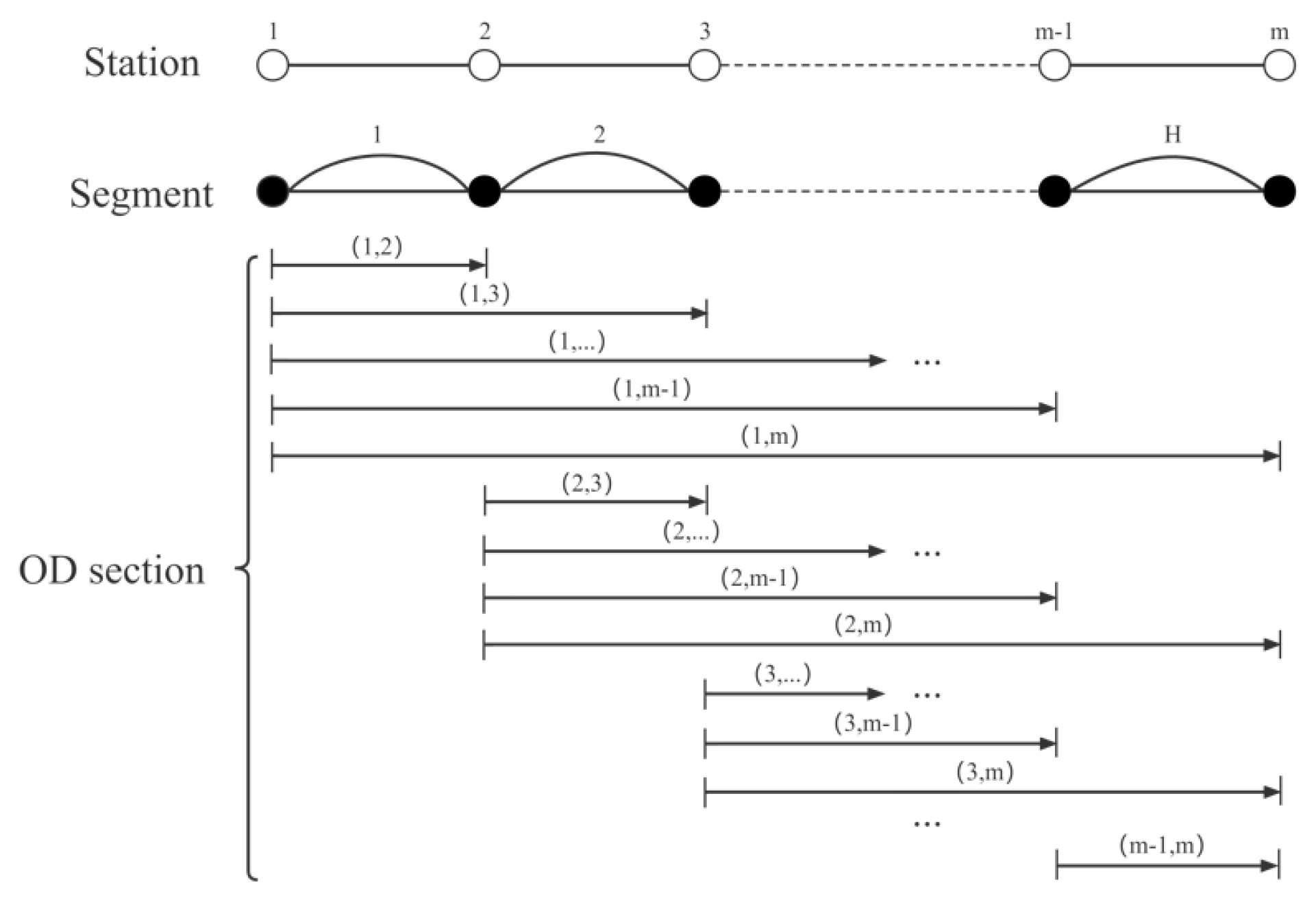

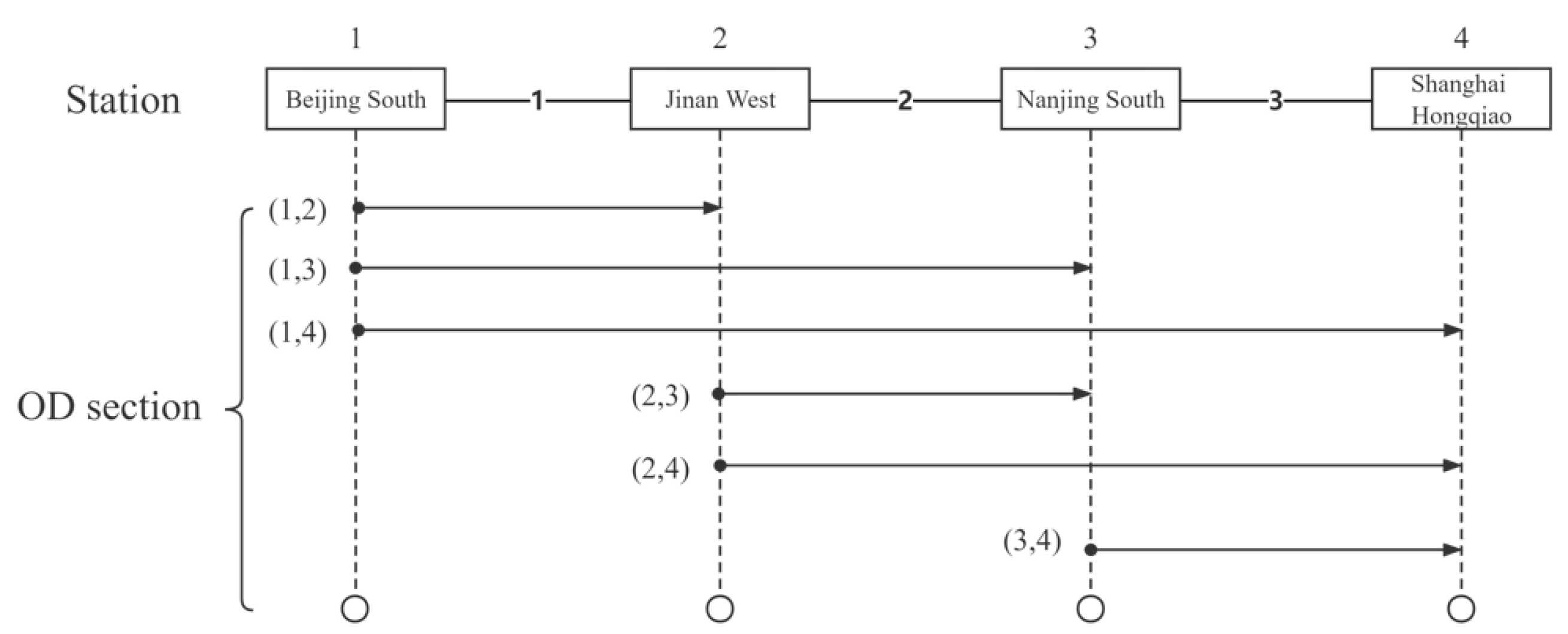

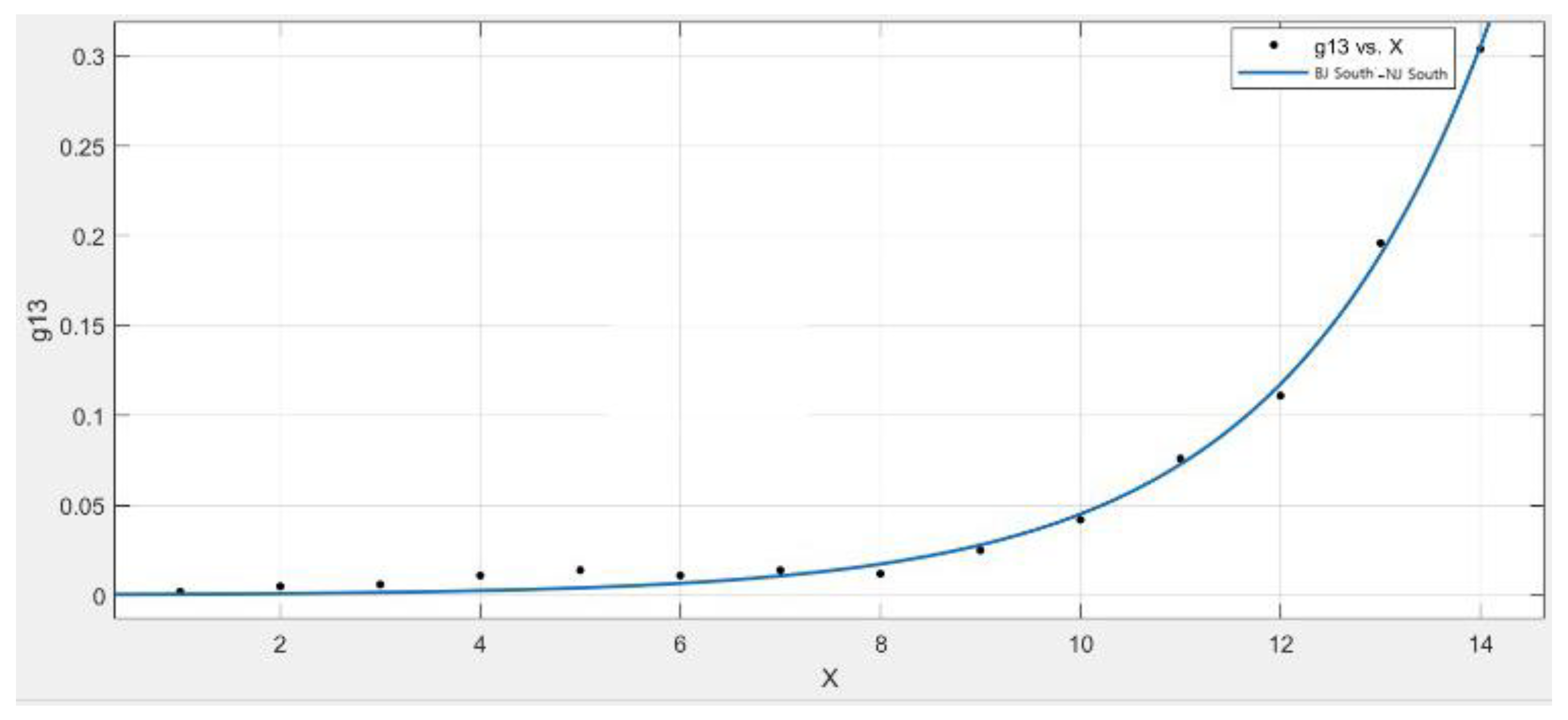
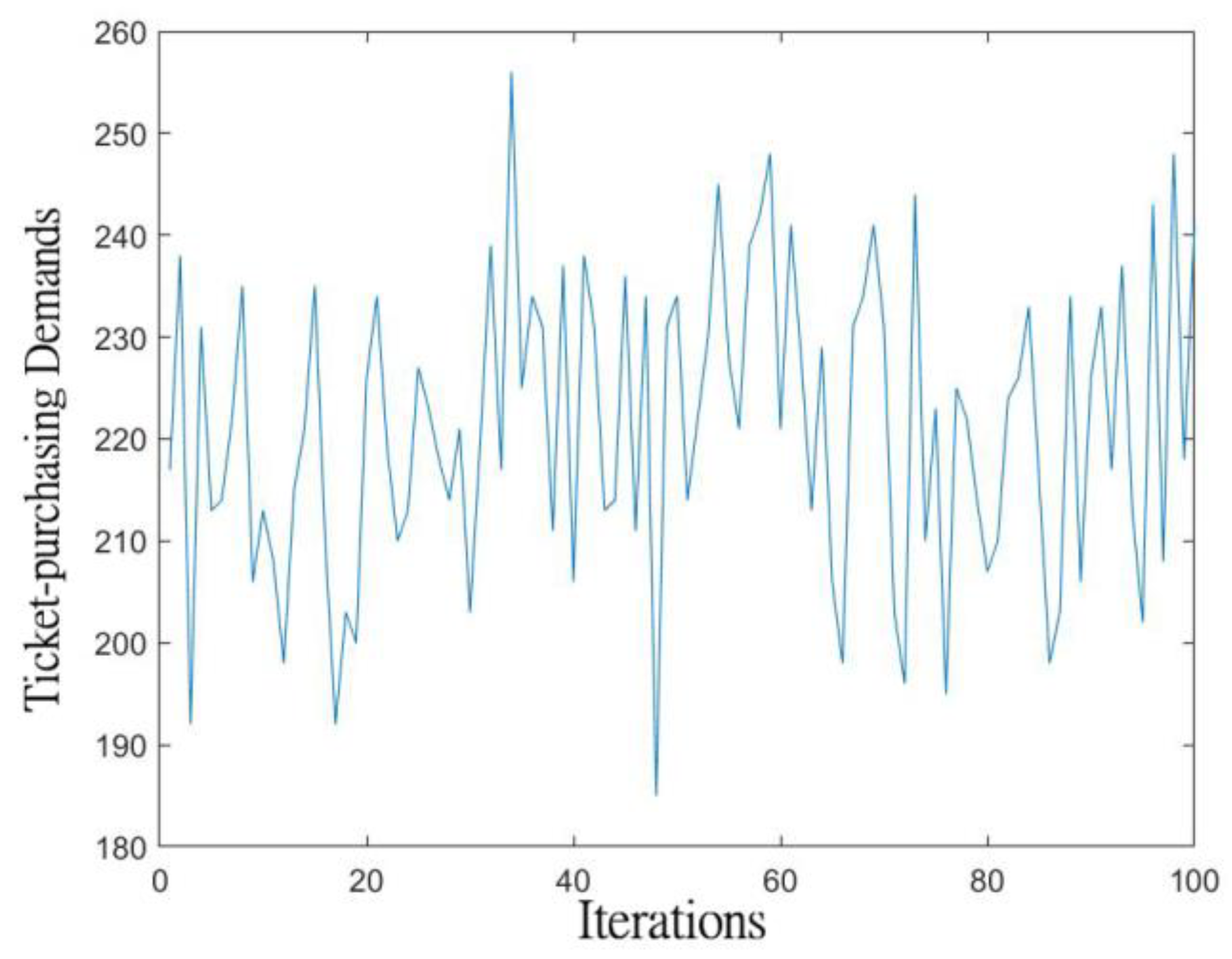
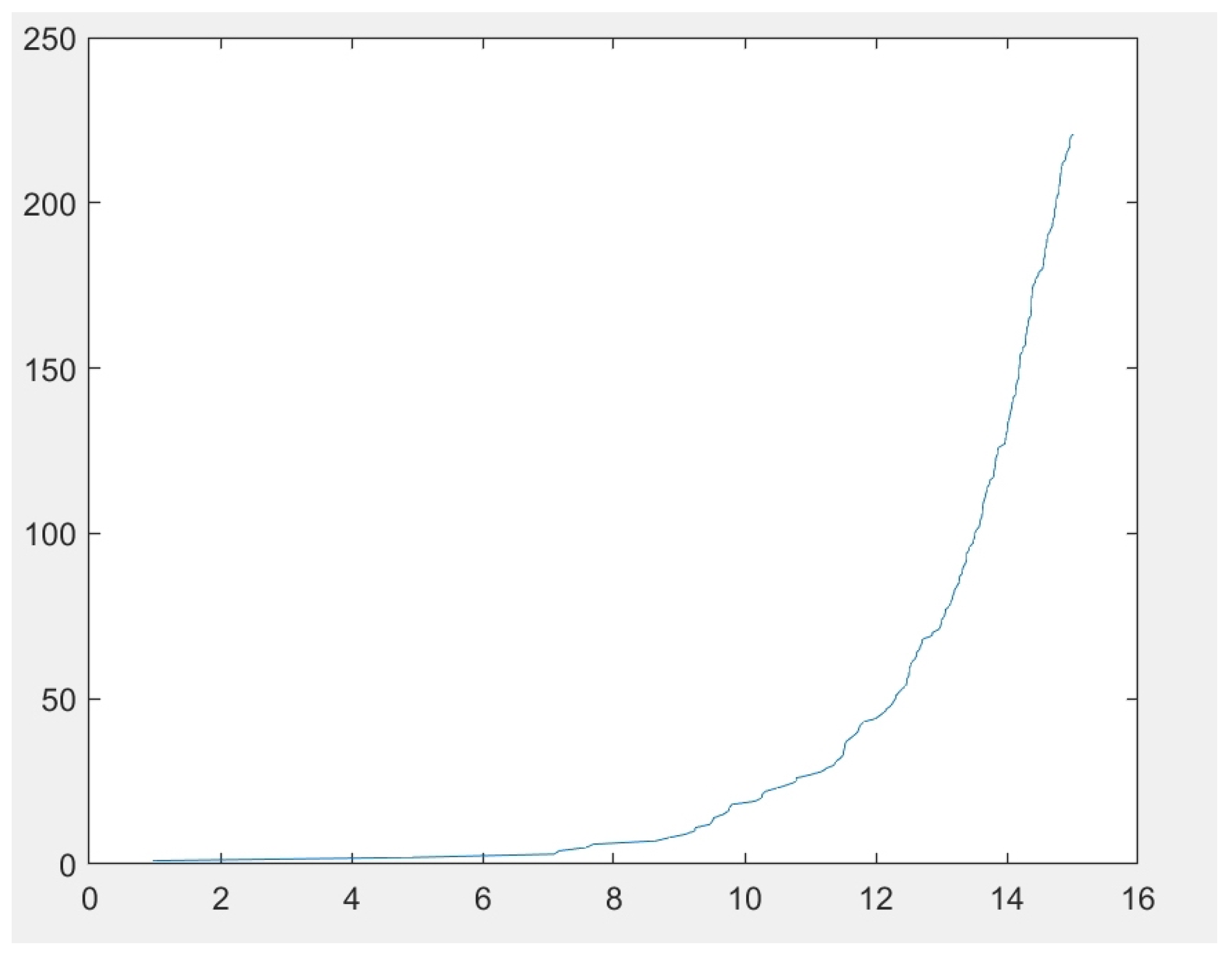
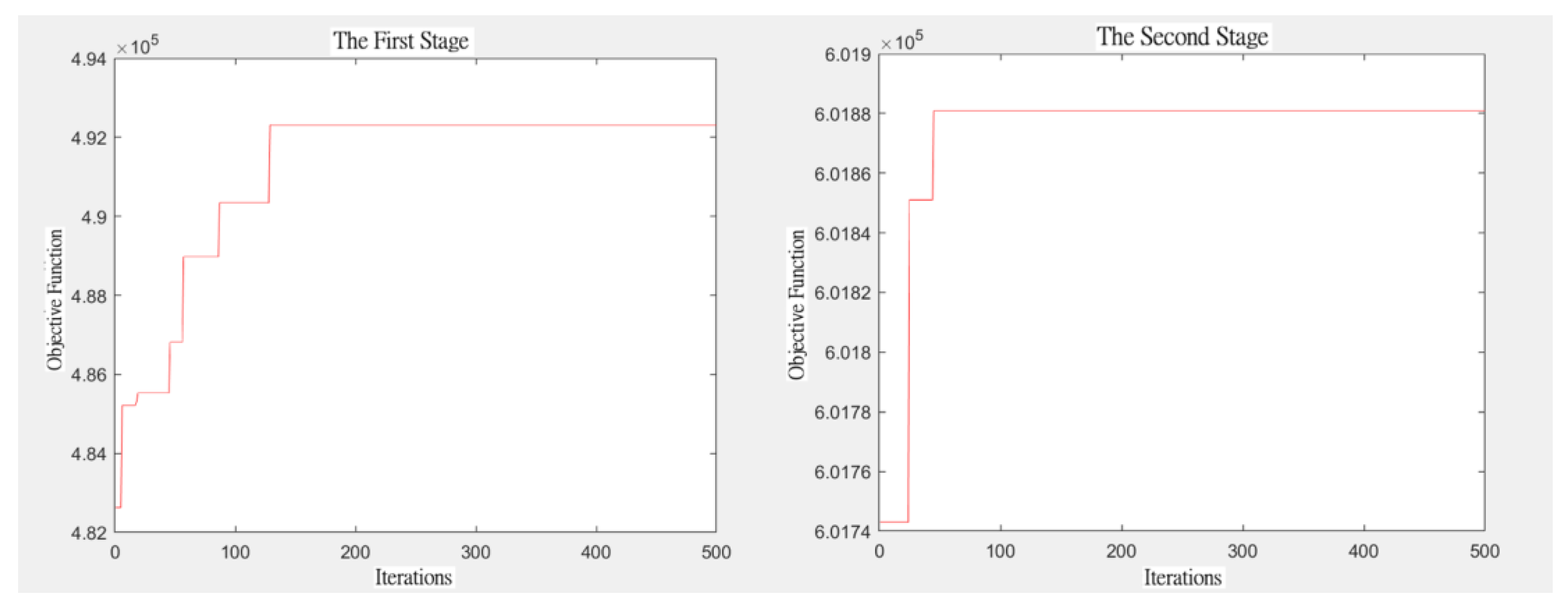
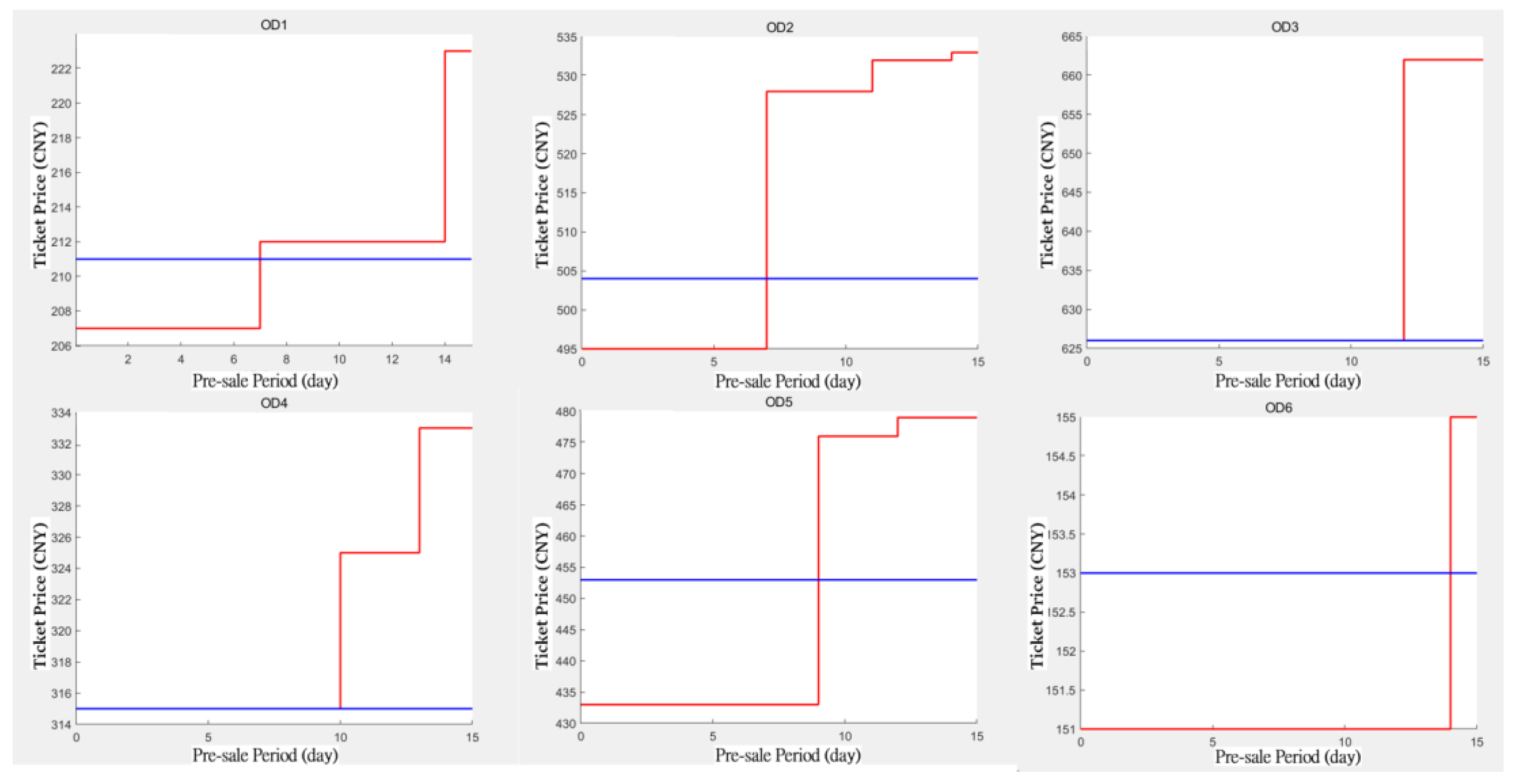
| Notations | Definition | Unit |
|---|---|---|
| The number of stations on a certain high-speed railway line | stations | |
| The number of segments on this HSR line; | segments | |
| The segment number is | ||
| A 0-1 variable indicates the occupancy of the current segment—if the current segment is occupied, the value is 1; otherwise, the value is 0 | ||
| The OD section from station to station on this HSR line, where represents the passenger origin station and represents the passenger destination station: | ||
| A collection of divided pre-sale periods in section | ||
| The tth period of the pre-sale period, | ||
| The tth period of the pre-sale period in section contains days | ||
| The published ticket price of the section | CNY | |
| The actual ticket price of the section | CNY | |
| The rated passenger capacity of this type of train | passengers | |
| The seat capacity of the train in segment (The seat capacity of the train in each segment is equal to the rated passenger capacity of the train, without considering the condition of overcrowding and overselling.) | seats | |
| The mileage of the section | km | |
| The full mileage of the train | km | |
| The revenue of the train | CNY | |
| The flexibility coefficient of the price at the tth period of the pre-sale period | ||
| The stochastic ticket-purchasing demand in section at the tth period of the pre-sale period at the actual price | tickets | |
| The expected value of stochastic ticket-purchasing demand in section at the tth period of the pre-sale period at the actual price | ||
| The dynamic passenger demand of section at the tth period of the pre-sale period | tickets | |
| The number of tickets pre-allocated in section | tickets | |
| The passenger flow volume exceeding the number of tickets allocated in the former T-1 periods of the pre-sale period in section | passengers | |
| A 0–1 variable, if is non-negative, ; otherwise, | ||
| If the ticket-purchasing demands of passengers are not satisfied in the former T-1 periods of the pre-sale period in section , the passengers will choose to purchase standby tickets with a probability of | ||
| Decision Variables | Definition | Unit |
| The price at the tth period of the pre-sale period in section | CNY | |
| The number of tickets allocated at the tth period of the pre-sale period in section | tickets |
| OD Section | Origin Station | Destination Station | Ticket Pre-Allocation |
|---|---|---|---|
| (1,2) | Beijing South | Jinan West | 131 |
| (1,3) | Beijing South | Nanjing South | 234 |
| (1,4) | Beijing South | Shanghai Hongqiao | 548 |
| (2,3) | Jinan West | Nanjing South | 136 |
| (2,4) | Jinan West | Shanghai Hongqiao | 173 |
| (3,4) | Nanjing South | Shanghai Hongqiao | 134 |
| OD Section | Average Value | Standard Deviation | Ticket Price/CNY | Mileage/km |
|---|---|---|---|---|
| (1,2) | 121 | 12.50 | 211 | 406 |
| (1,3) | 215 | 22.67 | 504 | 1023 |
| (1,4) | 507 | 48.97 | 626 | 1318 |
| (2,3) | 125 | 13.70 | 315 | 617 |
| (2,4) | 160 | 15.70 | 453 | 912 |
| (3,4) | 123 | 13.91 | 153 | 295 |
| OD Section | Upper Limit/CNY | Actual Price/CNY | Lower Limit/CNY |
|---|---|---|---|
| (1,2) | 223 | 211 | 202 |
| (1,3) | 533 | 504 | 481 |
| (1,4) | 662 | 626 | 598 |
| (2,3) | 333 | 315 | 301 |
| (2,4) | 479 | 453 | 433 |
| (3,4) | 162 | 153 | 146 |
| Function Types | Statistical Parameters | |||
|---|---|---|---|---|
| SSE | R-Square | Adjusted-Square | RMSE | |
| Primary Function | 0.039480 | 0.0169 | 0.5850 | 0.057530 |
| Quadratic Function | 0.000323 | 0.9120 | 0.8959 | 0.028720 |
| Cubic Function | 0.000759 | 0.9926 | 0.9904 | 0.008710 |
| Linear Function | 0.083200 | 0.1928 | 0.4606 | 0.086970 |
| Exponential Function | 0.000380 | 0.9963 | 0.9960 | 0.005626 |
| Power Function | 0.000655 | 0.9936 | 0.9931 | 0.007385 |
| Primary Function | 0.039480 | 0.0169 | 0.5850 | 0.057530 |
| OD Section | t = 1 | t = 2 | t = 3 | t = 4 |
|---|---|---|---|---|
| (1,2) | Days 1 to 7 | Days 8 to 12 | Days 13 to 14 | The 15th day |
| (1,3) | Days 1 to 7 | Days 8 to 11 | Days 12 to 14 | The 15th day |
| (1,4) | Days 1 to 9 | Days 10 to 12 | Days 13 to 14 | The 15th day |
| (2,3) | Days 1 to 10 | Days 11 to 13 | The 14th day | The 15th day |
| (2,4) | Days 1 to 9 | Days 10 to 12 | Days 13 to 14 | The 15th day |
| (3,4) | Days 1 to 9 | Days 10 to 13 | The 14th day | The 15th day |
| OD Section | t = 1 | t = 2 | t = 3 | t = 4 | Total | Error |
|---|---|---|---|---|---|---|
| (1,2) | 10 | 23 | 65 | 26 | 124 | 2.48% |
| (1,3) | 20 | 50 | 120 | 31 | 221 | 2.79% |
| (1,4) | 51 | 118 | 259 | 89 | 517 | 1.97% |
| (2,3) | 11 | 47 | 39 | 32 | 129 | 3.2% |
| (2,4) | 15 | 44 | 75 | 31 | 165 | 3.13% |
| (3,4) | 11 | 38 | 35 | 42 | 126 | 3.28% |
| OD Section | Ticket Price/CNY | Number of Ticket Sales/Tickets | ||||||
|---|---|---|---|---|---|---|---|---|
| t = 1 | t = 2 | t = 3 | t = 4 | t = 1 | t = 2 | t = 3 | t = 4 | |
| (1,2) | 207 | 212 | 212 | 223 | 11 | 23 | 63 | 25 |
| (1,3) | 495 | 520 | 532 | 533 | 20 | 50 | 114 | 31 |
| (1,4) | 626 | 626 | 662 | 662 | 53 | 113 | 247 | 85 |
| (2,3) | 315 | 325 | 333 | 333 | 11 | 48 | 38 | 31 |
| (2,4) | 433 | 476 | 479 | 479 | 15 | 42 | 72 | 30 |
| (3,4) | 151 | 151 | 151 | 155 | 12 | 39 | 33 | 40 |
| Scheme | Origin Station | Destination Station | Ticket Price/CNY | Ticket Allocation/Tickets | ||||||
|---|---|---|---|---|---|---|---|---|---|---|
| t = 1 | t = 2 | t = 3 | t = 4 | t = 1 | t = 2 | t = 3 | t = 4 | |||
| Joint Optimization Scheme | Beijing South | Jinan West | 207 | 212 | 212 | 223 | 11 | 23 | 63 | 25 |
| Beijing South | Nanjing South | 495 | 520 | 532 | 533 | 20 | 50 | 114 | 31 | |
| Beijing South | Shanghai Hongqiao | 626 | 626 | 662 | 662 | 53 | 113 | 247 | 85 | |
| Jinan West | Nanjing South | 315 | 325 | 333 | 333 | 11 | 48 | 38 | 31 | |
| Jinan West | Shanghai Hongqiao | 433 | 476 | 479 | 479 | 15 | 42 | 72 | 30 | |
| Nanjing South | Shanghai Hongqiao | 151 | 151 | 151 | 155 | 12 | 39 | 33 | 40 | |
| Revenue/CNY | 601,881 | |||||||||
| Comparison Scheme | Beijing South | Jinan West | 211 | 124 | ||||||
| Beijing South | Nanjing South | 504 | 221 | |||||||
| Beijing South | Shanghai Hongqiao | 626 | 517 | |||||||
| Jinan West | Nanjing South | 315 | 129 | |||||||
| Jinan West | Shanghai Hongqiao | 453 | 165 | |||||||
| Nanjing South | Shanghai Hongqiao | 153 | 126 | |||||||
| Revenue/CNY | 595,848 | |||||||||
Publisher’s Note: MDPI stays neutral with regard to jurisdictional claims in published maps and institutional affiliations. |
© 2022 by the authors. Licensee MDPI, Basel, Switzerland. This article is an open access article distributed under the terms and conditions of the Creative Commons Attribution (CC BY) license (https://creativecommons.org/licenses/by/4.0/).
Share and Cite
Yin, X.; Liu, D.; Rong, W.; Li, Z. Joint Optimization of Ticket Pricing and Allocation on High-Speed Railway Based on Dynamic Passenger Demand during Pre-Sale Period: A Case Study of Beijing–Shanghai HSR. Appl. Sci. 2022, 12, 10026. https://doi.org/10.3390/app121910026
Yin X, Liu D, Rong W, Li Z. Joint Optimization of Ticket Pricing and Allocation on High-Speed Railway Based on Dynamic Passenger Demand during Pre-Sale Period: A Case Study of Beijing–Shanghai HSR. Applied Sciences. 2022; 12(19):10026. https://doi.org/10.3390/app121910026
Chicago/Turabian StyleYin, Xiaofeng, Di Liu, Wenyu Rong, and Zheng Li. 2022. "Joint Optimization of Ticket Pricing and Allocation on High-Speed Railway Based on Dynamic Passenger Demand during Pre-Sale Period: A Case Study of Beijing–Shanghai HSR" Applied Sciences 12, no. 19: 10026. https://doi.org/10.3390/app121910026
APA StyleYin, X., Liu, D., Rong, W., & Li, Z. (2022). Joint Optimization of Ticket Pricing and Allocation on High-Speed Railway Based on Dynamic Passenger Demand during Pre-Sale Period: A Case Study of Beijing–Shanghai HSR. Applied Sciences, 12(19), 10026. https://doi.org/10.3390/app121910026






